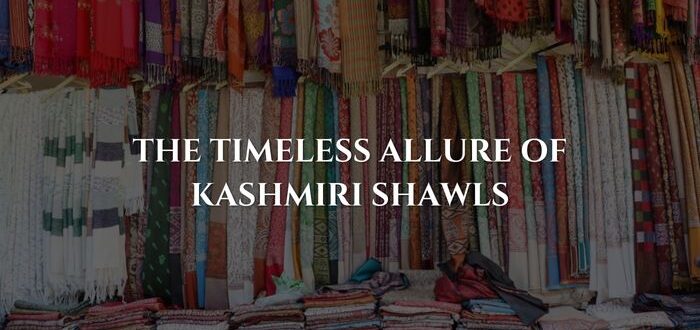The Timeless Allure of Kashmiri Shawls
A Kashmiri shawl is a woolen garment from India’s Kashmir region that has been elegantly woven or embroidered. These shawls, made most of pashmina wool from the high Himalayas, are adored worldwide for their extraordinary quality, unique designs, and gorgeous embroidery.

The term “shawl” originates from Persian and refers to a garment draped over the body. Typically rectangular in design, Kashmiri shawls provide warmth and a touch of elegance, making them versatile pieces that can be dressed in various ways.
The Rich History of Kashmiri Shawls
Kashmiri shawls have a long history, dating back to the 3rd century BC, when they were created by Kashmiri weavers to shelter themselves from the harsh winters. Over the years, these shawls evolved into a recognised art form, with artists creating exquisite designs that were treasured by royalty and the privileged. Mughal and Persian influences can be seen in the delicate floral and paisley patterns, as well as the rich colours and gold thread employed in their embroidery. The use of expensive materials such as pashmina and shahtoosh wool enhanced its rarity and prestige. Still today, Kashmiri shawls are a symbol of elegance and refinement, acclaimed for their excellent craftsmanship and beauty, and much sought after by collectors and aficionados.

Mughal and Persian Impact On Artistry
The Mughal and Persian eras’ cultural influence had a significant impact on Kashmiri shawl manufacture, particularly in the 14th and 15th centuries. The Mughals, renowned patrons of the arts, were instrumental in encouraging the production of high-quality textiles, such as Kashmiri shawls. The delicate floral and paisley motifs on these shawls, as well as the use of vibrant colours and gold thread in their embroidery, show a Persian influence. Mughal and Persian traditions continue to have an impact on Kashmiri artists’ elaborate designs and patterns.
The Shift From Shahtoosh To Pashmina
For generations, pashmina, derived from the Changthangi goat, was the principal material utilized to make these gorgeous shawls. However, in the nineteenth century, artisans began working with a new, even finer wool called shahtoosh. Shahtoosh, derived from the Tibetan antelope, is renowned for its extraordinary softness and delicate texture, making it the ideal epitome of luxury. Unfortunately, due to the Tibetan antelope’s endangered condition, the production of shahtoosh shawls has been outlawed. As a result, pashmina is once again the primary material used to make these shawls. Today, Kashmiri shawl-making is done using traditional ways, safeguarding this age-old craft for future generations.
The Cultural Importance of Kashmiri Shawls
For generations, Kashmiri shawls have represented luxury and extravagance, worn by royalty, nobles, and the wealthy. These exquisitely handmade pieces, made of pashmina, shahtoosh, and silk, were highly valued for their elaborate designs and became cherished emblems of prestige and power.
Kashmiri shawls were treasured family relics that were meticulously conserved and only worn on rare occasions. They were frequently passed down through generations. Families saw these shawls as more than just belongings; they were treasured works of art that represented legacy and custom.

A Timeless Statement in Modern Fashion
In recent years, contemporary fashion has embraced traditional designs and materials, particularly Kashmiri shawls, resulting in creative and one-of-a-kind pieces that emphasize their beauty and adaptability.
Designers frequently use Kashmiri shawls as standout items, mixing them with more straightforward clothes such as solid-colored skirts or jackets. The mix of elaborate shawl designs and vibrant colours with understated clothing adds elegance, resulting in a classy yet trendy look.
Additionally, Kashmiri shawls are used as adornment in contemporary designs. Shawl textiles, for example, could be utilised as jacket trim or embroidered into blouses and skirts. These innovative uses elevate current design while highlighting the delicate beauty of Kashmiri shawls.
The shawl industry supports indigenous artists and weavers in Kashmir. Many families have practiced this craft for decades and rely on it for a living. By promoting Kashmiri shawls, the fashion industry not only protects cultural history but also helps local people.
Overall, the use of Kashmiri shawls in modern fashion proves its timeless appeal and versatility. This trend not only honours traditional craftsmanship, but also promotes innovation and originality in the fashion industry.
Tales Woven in Wools
The Moonlit Elegance of Jamawar Shawls
The Jamawar shawl is one of the most famous and admired Kashmiri shawls, known for its intricate patterns and gorgeous design. According to legend, the patterns were so fine that they were thought to be made of moonlight strands that could only be seen at a full moon phase. Traditionally, these shawls were made with a handloom.
The shawl is made of excellent pashmina wool sourced from the high-altitude regions of Ladakh and Tibet, which is hand-processed and spun before weaving. It is then embroidered with the sozni technique, resulting in the complex designs that distinguish Jamawar shawls.
Today, Jamawar shawls are prized for their beauty and artistry, and are frequently regarded as a symbol of wealth and prestige. The intricate motifs represent decades of expertise and tradition honed by Kashmiri weavers. The wonderful legend of moonlight only adds to the attractiveness of these magnificent shawls.

Exquisite Jamawar Shawl at Giftex auction
We featured a stunning Jamawar Wool Shawl in our auction that truly caught the eye. The shawl showcased a beautiful black central medallion surrounded by large paisley patterns in vibrant shades of pink, orange, yellow, and brown.
What made it even more special were the vividly colored borders, adorned with a mix of reds, pinks, yellows, blues, whites, greens, and blacks. This piece perfectly captured the ornate designs that Jamawar fabrics are known for. It was a fantastic addition to our auction, celebrating the beauty of traditional craftsmanship.
The Supernatural Craft of Kani Shawl Weavers
The Kani shawl is one of the most famous and valuable Kashmiri shawls, known for its brilliant colours and intricate motifs. Making Kani shawls has been passed down through centuries and is regarded as one of the most complicated weaving techniques.
According to legend, Kani shawl weavers have supernatural abilities that allowed them to visualize elaborate designs in their brains and weave them straight into the fabric without the use of physical guides. This extraordinary skill gained them immense respect, particularly among royalty and the elite, and helped many weavers achieve fame and fortune.
Even today, Kani shawls are highly valued for their beauty and craftsmanship, representing richness and status. The Kani loom is a major element, allowing artists to create precise patterns using a specific code known as Taliim. This distinctive method distinguishes the Kani shawl from other Kashmiri shawls.
The history of the Kani weavers exemplifies the exceptional skill and heritage of Kashmiri craftspeople, whose ability has been refined over the ages. Their legacy is preserved and commemorated via the ongoing production of these gorgeous shawls.
Shahtoosh Shawls: A Tapestry of Royal Tradition
Shahtoosh shawls are famous for their remarkable softness and warmth, as they are produced from the delicate hair of the Tibetan antelope. These shawls, once regarded as the ultimate luxury, were in high demand among royalty and the rich elite.
According to legend, Shahtoosh shawls were so costly that they were only worn by royalty and were regarded as precious as gold. They were frequently exchanged as gifts between rulers and nobility, representing authority and dignity.

Making these shawls needed a great deal of expertise and precision. The antelope’s fine hair had to be harvested by hand, and weaving the shawl required exceptional patience and attention to detail.
Shahtoosh shawls are no longer produced or sold in order to protect the endangered Tibetan antelope, yet their legacy lives on. These wonderful artefacts, with their royal history, are still admired in the world of art and craftsmanship.
The story of Shahtoosh shawls reflects the high value placed on luxury products in the past, as well as the expertise of Kashmiri weavers who developed their technique over ages.
Kashmiri shawls, known for their intricate patterns and luxurious materials, are an example of artisanal artistry. These shawls encapsulate Kashmir’s rich cultural legacy, with talented weavers weaving stories of tradition into each thread. The combination of fine pashmina wool, brilliant colours, and complex stitching techniques elevates each shawl to the level of a masterpiece, transforming it from an accessory to an artwork.

Bid & bring home timeless treasures
At Giftex, in addition to Kashmiri shawls, our collection includes a wonderful selection of textiles that reflect the richness and inventiveness of textile art. Every piece, from masterfully crafted carpets with intricate designs to vibrant tapestries telling stories of culture and history demonstrates craftsmen’s talent and passion.
Join us in celebrating these masterpieces and discovering the fascination of Kashmiri shawls and other exquisite textiles. Visit our forthcoming auction to find a selection that accurately reflects the artistry and cultural value of these timeless masterpieces.






